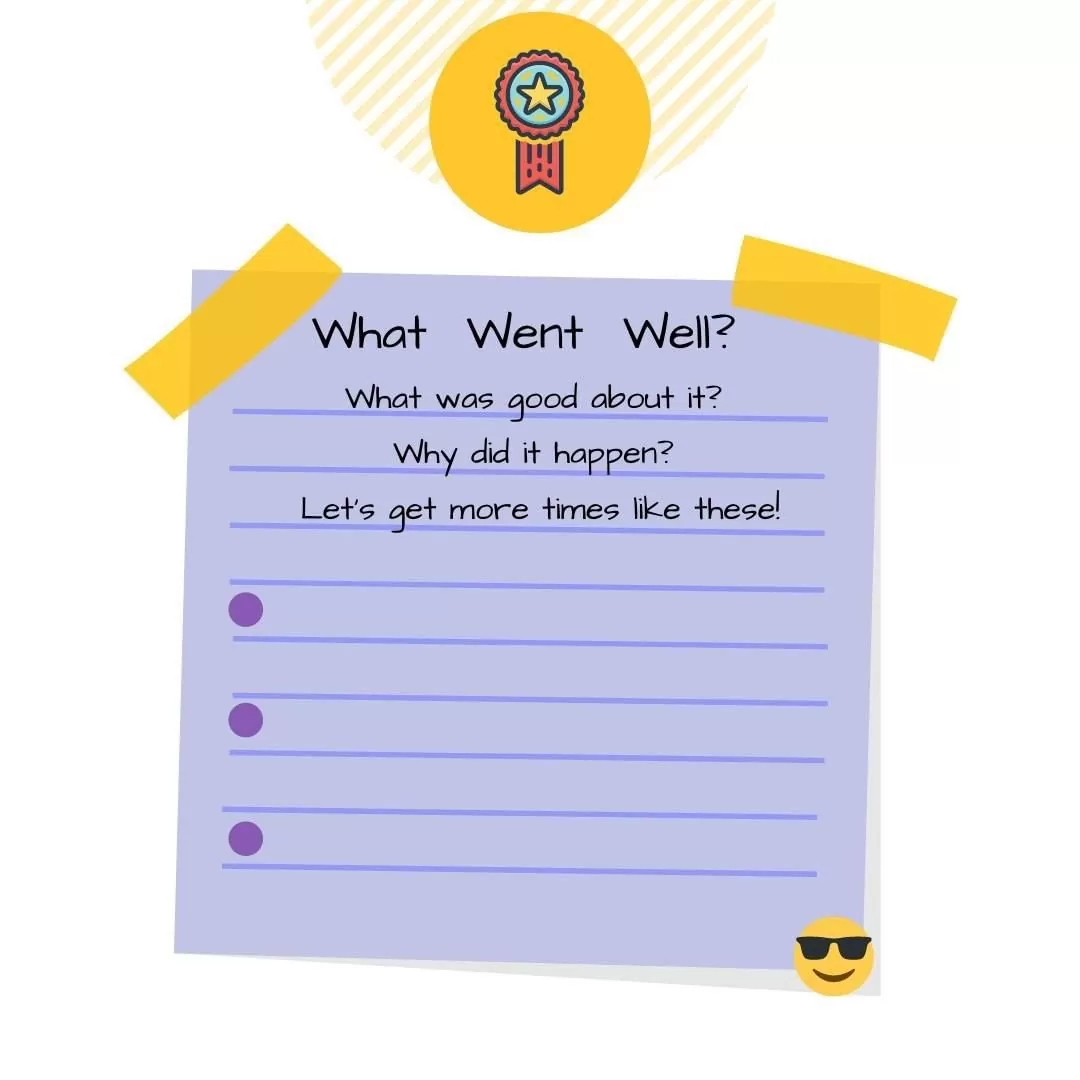Today's Monday • 9 mins read
— By Dr. Sandip Roy.
The Three Good Things (TGT) is a simple but powerful happiness-boosting practice. It only takes three minutes.
It comes from Positive Psychology—the science that explores the healthy side of mental health, like our psychological strengths, eudaimonia, and how we can flourish.
- Experts refer to happiness as positive affect or subjective well-being (SWB).
- TGT has been scientifically proven to raise our SWB or happiness level.
This is a short and easy guide to the Three Good Things (TGT), with examples and research.
Introducing Three Good Things (TGT)
Three Good Things (TGT) is a journaling activity. You write about 3 positive things in your journal for a week.
By the end of the week, you notice these changes:
- You see life events with less negativity and more optimism.
- You feel happier, more grateful, and self-compassionate.
How To Practice The Three Good Things (TGT)
In short, you think of 3 things that went well today, write them down, and reflect on them.
Step 1. Look back upon your day.
- Before you go to bed, sit down on your bed or a chair.
- Close your eyes and mentally look back on your day.
- Recall what you did, what things happened.

- Problems in Step 1: Humans are born with a negativity bias. So, when you reflect on your day, you tend to recall the negative things — a little accident, an unwanted comment, a rude remark, or a negativity-spouting person.
- Solution: At every negative event recall, tell yourself. “OK, that happened. Now, let me recall the next experience.” It allows you to notice and yet not dwell on the negative event.
Step 2. Think of 3 good things that happened.
- Ask yourself, “What went well today?”
- Pick out the three most positive highlights of your day.
- Make sure these are positive things — not the least negative ones.

- Problems in Step 2: Negative things may overshadow positive things, especially in the beginning.
- Solution: Take a few deep breaths and let yourself calm down. Ask yourself, “What’s the best good thing that happened to me today?”
Step 3. Write down the good things.
Write down the three positive events.
Even if they were small events, if they made you smile and feel happy, and were positive, write them down.
I suggest using a paper journal and a pen.

- Problems in Step 3: Physically writing down can feel tedious, making you rush through this step.
- Solution: Tell yourself, this is a chance to re-live the positive events in more details, expanding the experience.
Step 4. Reflect on the good things.
- Close your eyes and spend 15 to 20 seconds reflecting on each event.
- Visualize the event in detail, and think about what made it memorable.
- Think about how it was different, why it helped you, and how it was meaningful.

- Problems in Step 4: Your mind may try to rush you through the reflection step, and wander off to more current events worry about future.
- Solution: Take a few deep breaths to center yourself. Relax, and affirm to yourself, “This moment brought me joy/peace/gratitude.” Allow yourself to feel the positive emotions that happened with each experience.
That’s all there is to it. That is the shortest guide to TGT. Take up this positive challenge for your greater good—I urge you.

How Long To Do The TGT?
- Do it for a week initially.
- Then, do it once a week, as long as you want.
- For best results, do it weekly it for at least six weeks.
Build a simple ritual that you can practice as a pleasant escape, not a mundane routine.
What Themes To Explore in TGT?
Five themes you could explore by asking yourself:
- What one way I made the most meaningful use of my time today?
- What one helpful support did I have from my relationships today?
- What one good thing happened at my work/office/college today?
- What one good act of generosity or kindness did I do today?
- What one thing brought a smile to my heart today?

3 Good Things Examples
Stuck still about how to do it? Take a look at these examples to help you:
- A great feeling of love you felt when someone checked to find out how you were doing.
- It could be a token of appreciation someone gave you at your workplace. Or good feedback from a customer.
- It could be a simple, enjoyable occasion, such as a shared time of conversation and laughter with your family during supper.
- It may be a fruitful discussion on a sensitive topic (like relationship boundaries or personal space) you had with your children, parents, spouse, friends, or online connections.
- A joyful moment when you stopped to see a fabulous flower in bloom or a few cute puppies playing in abandon.
- It could be you looking at some old pictures of your friends and being flooded with positive thoughts and memories about them.
Don’t limit yourself to the above. Explore your possibilities. Many positive moments are waiting for you; seek them out.
Even if you find it difficult to bring up some good things at first, keep a glass-half-full attitude. Let’s find out how you can get them sooner.

Are there any rules for practicing TGT?
Rules of TGT: Writing, Reflecting, Timing.
The TGT practice needs three conditions to work well:
- Writing down is vital as it helps you to focus on the events in a properly structured way.
- Reflecting on what you did is essential, as it adds to your sense of control and perceived well-being.
- Timing is significant. Research says to get good results, do it daily for a week (or once a week for six weeks).
The real task is to approach your TGT practice sincerely and consistently. No one is judging you for it, and you too shouldn’t judge yourself for the low positivity in your days.
It is a happiness-boosting exercise. So, if it feels like an unhappy, tedious task you must endure every day, then it’s okay not to do it every day.
Do it for one week, then stop.
If you feel like it, come back to it for another week sometime later. Or do it specifically on days that had extraordinary positive events.
Why is TGT difficult at first?
Humanity evolved with a negative bias. Survival meant our brains constantly checked for dangers around us. That ancestral instinct came down to us, modern humans.
So we are more alert to negative events in our life. And it is tough to spot 3 good things at the start.
Martin Seligman, fondly called the Father of Modern Positive Psychology, explains it:
“For sound evolutionary reasons, most of us are not nearly as good at dwelling on good events as we are at analyzing bad events. Those of our ancestors who spent a lot of time basking in the sunshine of good events, when they should have been preparing for disaster, did not survive the Ice Age. So, overcoming our brains’ natural catastrophic bent, we need to work on and practice this skill of thinking about what went well.”
Solution: Remind yourself that your 3 good things don’t have to be special or spectacular. Your good things need not be winning a championship, grabbing a promotion, or getting engaged to your long-lost-found-again love.
Even finding marriage-heaven, whatever that means. Or something as earthshaking as escaping a prison sentence, though that counts.
Any three simple things that you are thankful for and are glad they happened, will count. Eventually, with a little practice, you will see good things light up like tiny sparkles.

What Are The Happiness Benefits of TGT?
Three Good Things (TGT) practitioners had their happiness levels rise by 2% after one week, 5% in one month, and 9% in six months.
Sheldon and Lyubomirsky investigated the effects of three good things in 2004, and Seligman, Steen, Park, and Peterson in 2005.
- TGT increases both hope and optimism (those are two different things).
- It also helps build a stronger immune system and greater job satisfaction.
- TGT practice also seems to increase a person’s psychological resilience.
- A Japanese study found it can effectively increase the general trust level in the participant.
Sheldon and Lyubomirsky (2004):
- At the one-month follow-up, participants in this exercise were happier and less depressed than they had been at baseline, and they stayed happier and less depressed at the three-month and six-month follow-ups.
- As we expected, our simple exercise was effective in producing higher levels of thankfulness and appreciation. More important, those participants who counted their blessings on a regular basis became happier as a result.
- Compared with a control group (i.e., people who did not practice TGT), the gratitude group reported significantly bigger increases in their happiness levels from before to after the intervention. Interestingly, this effect was observed only for those who expressed gratitude every Sunday night.
In 2009, Sin & Lyubomirsky combed through 51 studies on positive psychology interventions (like being asked to count their blessings), and found that people became noticeably happier when they were given individual positive interventions.
‘What Went Well’ in Positive Psychology?
Martin Seligman, widely known as the Father of Positive Psychology, explains the “What-Went-Well” happiness intervention in this video:
Transcript of the video (slightly edited for ease of reading):
The Three Good Things exercise has you write down for a week, before you go to sleep, three things that went well today, and then reflect on why they went well.
It works because it changes your focus from the things that go wrong in life to the things that you might take for granted that go well. And focusing your attention on things that go well breaks up depression and increases happiness.
I don’t need to recommend it beyond a week, typically for three good things. But when you do this, you’ll find you like it so much. Most people just keep doing it.
We ask people to write down the causes because we want people to reflect on and immerse themselves in the good events.
- Download: Three Good Things PDF
Final Words
TGT is simply finding and writing down three things that went well each day.
Try the TGT tonight—it may be the best 3 minutes of your day!
√ Also Read: Mindfulness For Beginners: 7-Step Guide
√ Please spread the word if you found this helpful.

